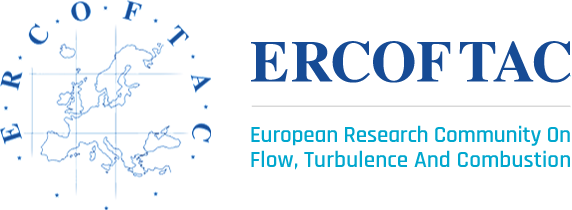ERCOFTAC PC Germany South
Shape Optimization of a 180° Bent Pipe to Reduce Flow Resistance
Authors: Eman Bagheri, Philipp Schlatter and Stefan Becker
(Institute of Fluid Mechanics (LSTM), Friedrich-Alexander-Universität (FAU) Erlangen-Nürnberg, Germany)
The video shows iso-contours of the λ2 criterion obtained from two high-fidelity Direct Numerical Simulations (DNS) of the flow through a 180° bent pipe at ReD=10,000. The first part of the video depicts a baseline bent circular pipe with curvature of 0.2 where unstable Dean vortices arise due to the imbalance between centrifugal force and the radial pressure gradient. The instability of these Dean vortices enhances the energy transfer rate to turbulent structures. The second part of the video shows an optimized design in which the incoming turbulence decays at the curved section of the pipe leading to local laminarization of the flow. The optimization achieves 58% reduction in the flow resistance, and the turbulence attenuation arises as a byproduct of the optimization. This work highlights that slight geometric modifications can profoundly impact turbulence dynamics, presenting a viable approach for turbulence control and energy efficient designs.
Scientific Abstract
Curved pipes are widely used in industrial applications in which reducing pressure loss and improving flow efficiency are often critical. Due to the imbalance between the centrifugal force and radial pressure gradient, secondary flow in the form of so-called Dean vortices is generated. At sufficiently high Reynolds numbers, the Dean vortices become unstable, intensifying turbulence at the bend and further downstream, leading to increased viscous losses downstream of the bend. In practice, a higher viscous loss results in a higher hydraulic resistance, and a proportionally higher pumping power required to drive the flow. This study, therefore, optimizes the shape of a 180° pipe (curvature 0.2) to minimize viscous losses under fully developed turbulent inflow conditions at ReD = 10,000. Our research builds on prior studies of curved pipe flow dynamics, in particular the DNS investigations by Noorani et al. [1,2] on substraight and sublaminar drag. The idea for optimization was also inspired by stability analyses by Canton et al. [3], where the flow stability in toroidal pipes is shown to be a function of both Reynolds number and curvature.
To validate the optimization, we perform two Direct Numerical Simulations (DNS) for both the baseline and optimized geometries. Flow visualizations using the λ2 criterion reveal that the baseline bend exhibits coherent unstable secondary structures that enhance turbulence at the exit of the bend. In contrast, the optimized geometry significantly reduces the turbulence intensity near the bend and promotes local laminarization. However, turbulence redevelops in the straight section further downstream in the form of growing turbulent patches due to residual disturbances advected from the bend. Moreover, the DNS results confirm a 58% reduction in flow resistance, demonstrating that geometric modifications can effectively control turbulence and reduce energy losses. Additional simulations at ReD = 20,000, as well as pressure measurements and PIV experiments in 3D printed pipes confirmed the drag-reducing property of the optimized geometry over a wider range of Reynolds numbers.
The results confirm that by locally changing both Reynolds number and curvature along the pipe, turbulence attenuation and even re-laminarization can be achieved simply by adjusting the shape of the pipe. Using free-form shape optimization based on the RANS equations, this study provides a strategy for energy-efficient curved pipe designs, with broader implications for turbulence control in engineering applications. The final visualizations were rendered remotely on the NHR-FAU cluster Fritz using ParaView 5.13 in 4K resolution.
1. Noorani, A., El Khoury, G.K., & Schlatter, P. (2013). Evolution of turbulence characteristics from straight to curved pipes. International Journal of Heat and Fluid Flow.
2. Noorani, A., & Schlatter, P. (2015). Evidence of sublaminar drag naturally occurring in a curved pipe. Physics of Fluids.
3. Canton, J., Schlatter, P., & Örlü, R. (2016). Modal instability of the flow in a toroidal pipe. Journal of Fluid Mechanics.
